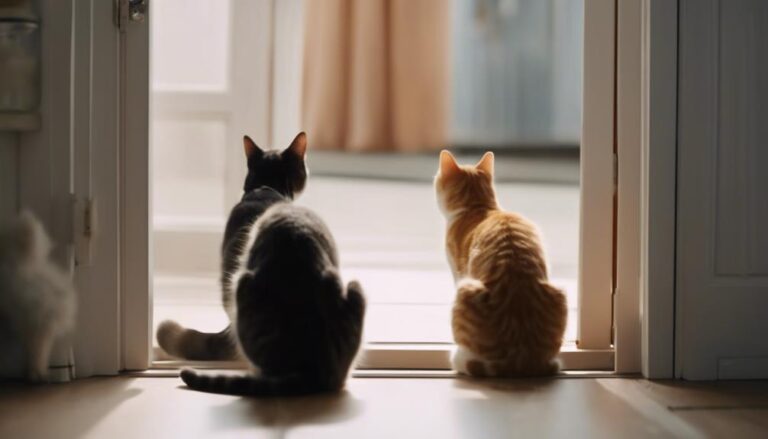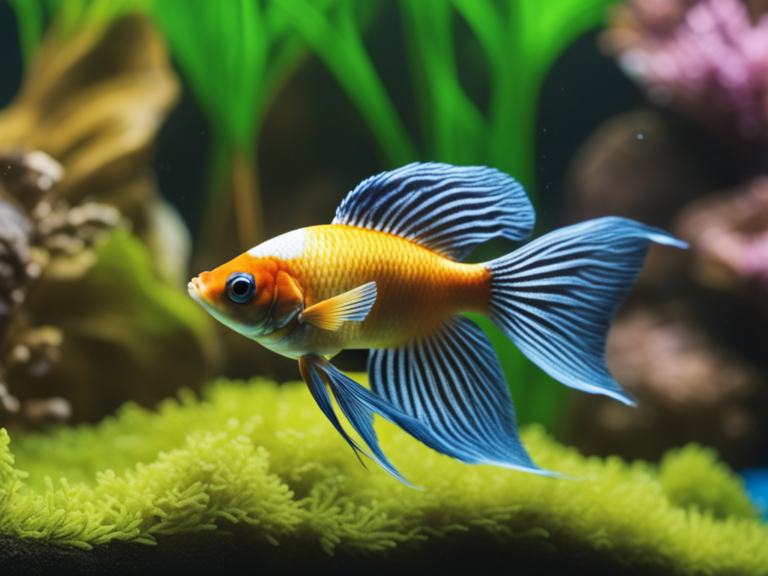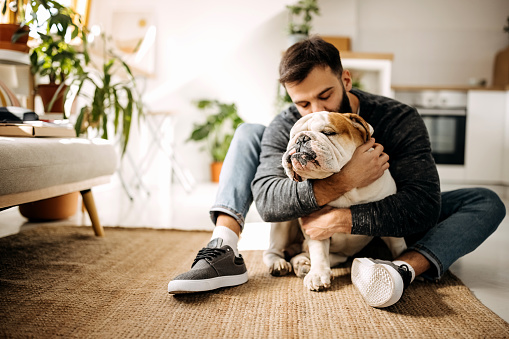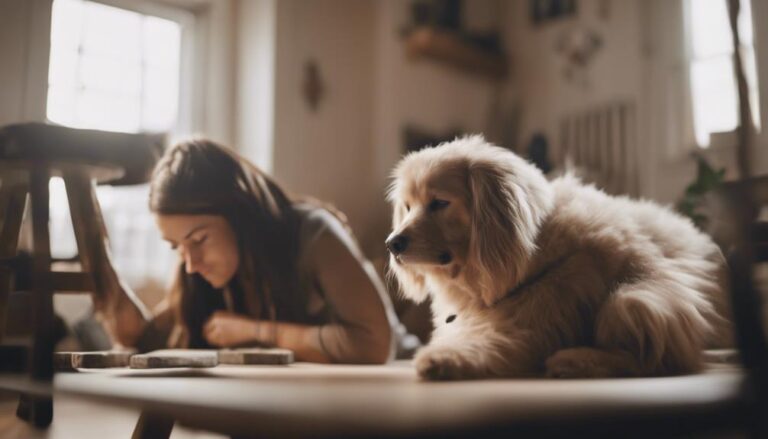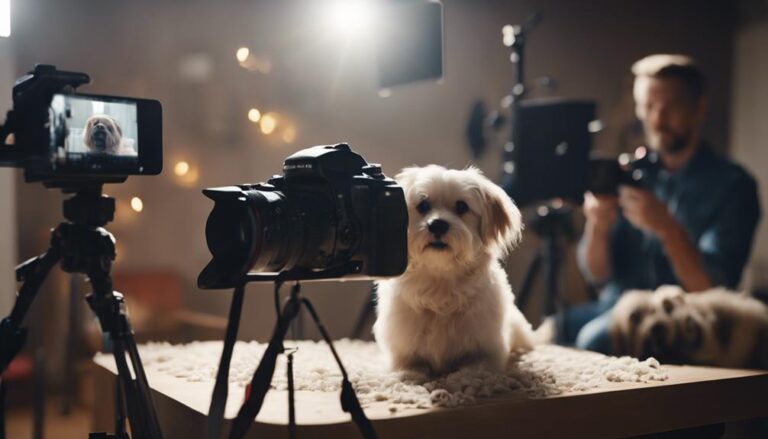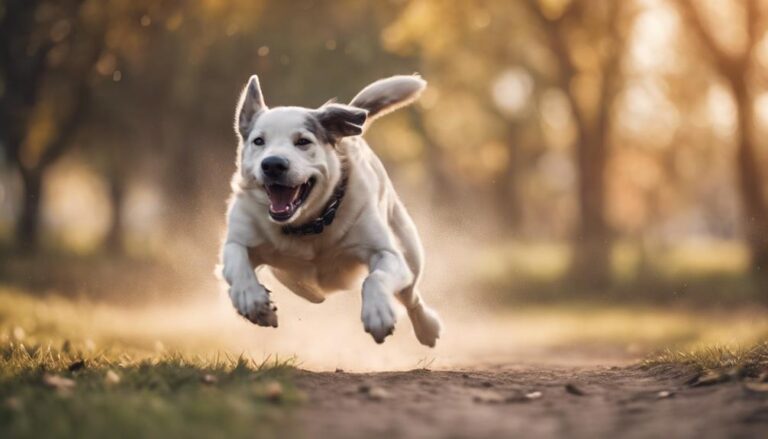Ready to master pet eye photography techniques? Discover how to enhance depth and mood in your pet's eyes. Zoom in for captivating mesmerizing close-ups and bring out textures for engagement. Experiment with editing tools to amplify colors and details. Handle uncooperative pets with patience and rewards. Build a strong bond for genuine connections in your photos. Consider breed-specific features for unique shots. Set yourself apart with creative pet eye photography. Learn the tips and tricks to showcase your furry friend's eyes like a pro!
Understanding Pet Eye Photography
Want to capture your pet's eyes in stunning detail? Understanding emotions plays a vital role in pet eye photography. Pets express a wide range of emotions through their eyes, from joy and excitement to fear and curiosity. By understanding these emotions, you can capture the true essence of your pet in your photographs.
When capturing details in your pet's eyes, pay attention to the lighting and angles. Natural light is ideal for showcasing the intricate details and colors in your pet's eyes. Experiment with different angles to find the most enchanting and alluring view. Zoom in to focus on the reflection and texture within the eyes, bringing out the unique characteristics that make your pet special.
To truly capture the emotions and details in your pet's eyes, establish a connection with them. Spend time bonding with your pet before the photoshoot to make them feel comfortable and at ease. This connection will shine through in the photographs, creating a deeper sense of intimacy and emotion.
Equipment Needed for Pet Eye Photography
To enhance your pet eye photography skills, having the right equipment is essential to capturing those stunning details. When it comes to capturing the vibrant colors of your pet's eyes, understanding your camera settings is vital. Adjusting the white balance can help bring out the true tones of your pet's eye color, ensuring they appear vivid and true to life in your photographs.
Selecting the right lens choice is critical for pet eye photography. A macro lens is ideal for capturing close-up shots of your pet's eyes, allowing you to focus on the intricate details and textures. This type of lens enables you to achieve sharp, detailed images that highlight the unique characteristics of your pet's eyes.
After capturing your pet eye photos, using editing software can help enhance the final results. You can adjust the brightness, contrast, and saturation to make the colors of your pet's eyes pop even more. Additionally, editing software allows you to fine-tune the sharpness and clarity of your images, ensuring every detail is crisp and well-defined.
Lighting Techniques for Pet Eye Photography
When capturing photos of your furry friends, consider the benefits of using natural light to enhance their eye colors. Experimenting with artificial light can create unique effects and bring out different tones in their eyes. Utilizing reflective surfaces can help you control and manipulate the light for stunning pet eye photography results.
Natural Light Benefits
Optimizing natural light enhances the vibrancy and depth of pet eye photography captures. When conducting outdoor sessions, take advantage of the soft, warm glow of sunlight. Sunlight benefits pet eye photography by providing a natural illumination that brings out the colors and details in your pet's eyes. Position your pet so the sunlight falls gently on their face, creating an enchanting sparkle in their eyes. For indoor shots, utilize window light to achieve a similar effect. Window light offers a soft and diffused lighting source that can highlight your pet's eyes beautifully. Experiment with different angles and curtains to control the intensity and direction of the light, resulting in stunning pet eye photography with natural light.
Artificial Light Effects
Enhancing your pet eye photography with artificial light effects can add an engaging and dynamic dimension to your captures. By incorporating creative lighting techniques, you can create stunning pet eye portraits that stand out. Experimenting with unique perspectives and artificial light effects allows you to highlight different aspects of your pet's eyes, bringing out their individuality and personality in the photos. Try using different types of artificial light sources such as LED lights, flashlights, or colored gels to add depth and interest to your pet eye portraits. Adjusting the angle and intensity of the light can help you achieve the desired mood and ambiance in your photos, making them visually compelling and unique.
Reflective Surfaces Utilization
Utilizing reflective surfaces in your pet eye photography can elevate the visual appeal and depth of your images, adding an enchanting dimension to your captures. Experiment with creative angles to capture unique reflections in your pet's eyes, enhancing the overall composition. By incorporating different textures, such as shiny metal or rippling water, you can create mesmerizing patterns within the eyes, drawing the viewer in. When using reflective surfaces, consider taking macro close-ups to focus on intricate details and highlight the fascinating reflections. These techniques not only add interest to your pet eye photography but also provide a creative way to play with light and textures, resulting in stunning and dynamic images.
Composition Tips for Pet Eye Photography
To capture striking pet eye photos, make sure the composition highlights their unique gaze and personality. When focusing on composition tips for pet eye photography, consider the following:
- Rule of Thirds: Position your pet's eyes along the intersecting lines or at the intersections of the grid to create a visually appealing composition.
- Negative Space: Leave room around your pet's eyes in the frame to draw attention to their gaze and create a sense of balance in the photo.
- Leading Lines: Use elements such as fur patterns, toys, or furniture to guide the viewer's eye towards your pet's eyes, enhancing the focus on their gaze.
- Background Selection: Opt for simple or blurred backgrounds to prevent distractions and maintain the pet's eyes as the focal point of the image.
Capturing Emotions in Pet Eye Portraits
To capture the emotions in your pet's eyes, focus on their gaze, as it can convey a range of feelings from curiosity to joy. Utilize lighting techniques that enhance the expression in their eyes, bringing out the depth of their emotions. Pay close attention to the details in their pupils, as they can reveal a lot about your pet's mood and personality.
Emotions Through Gaze
When capturing emotions in pet eye portraits, focus on the intensity of the gaze to convey the depth of feeling. Understanding pet emotions through their gaze interpretation is key to capturing compelling portraits. To master this technique, consider the following:
- Eye Contact: Establish a connection through direct eye contact with the pet to evoke a sense of intimacy and emotion.
- Pupil Dilation: Note the size of the pupils as they can reveal excitement, fear, or relaxation, adding depth to the portrait.
- Eyelid Position: The position of the eyelids can convey a range of emotions, from curiosity to contentment.
- Eye Movement: Capture moments of stillness or movement in the eyes to reflect different moods and expressions.
Lighting for Expression
Capture the emotions in pet eye portraits by strategically using lighting to enhance the expression in their gaze. To convey different moods effectively, consider the color temperature of the light source. Warm tones evoke a sense of comfort, while cooler tones can create a more somber or mysterious feel. Experiment with positioning the light to create catchlights in your pet's eyes. Catchlight placement can add depth and intensity to their gaze, making their eyes appear more alive and engaging. By mastering these lighting techniques, you can bring out the unique personality and emotions of your furry subjects in their eye portraits. Experiment with different lighting setups to see how it affects the overall expression captured in your pet's eyes.
Focus on Pupil Details
Focusing on the intricate details of your pet's pupils can effectively convey a wide range of emotions in their eye portraits. When capturing pet eye portraits, pay special attention to:
- Pupil reflections: Explore how light interacts with your pet's eyes, reflecting the environment and adding depth to the image.
- Color variations: Notice how different lighting conditions can alter the color of your pet's pupils, affecting the overall mood of the portrait.
- Macro close-ups: Zoom in to reveal the tiny details within your pet's eyes, showcasing the unique patterns and textures that make them special.
- Eye textures: Highlight the various textures present in your pet's eyes, from smooth surfaces to intricate patterns, to create engaging and emotive portraits.
Editing and Enhancing Pet Eye Photos
To enhance the allure of your pet eye photos, consider utilizing editing techniques that bring out the vibrant colors and details. Enhancing colors can make your pet's eyes stand out in the photo, creating an engaging and lively look. When editing, you can experiment with creative filters to add a distinctive touch to the images. Filters can help enhance the mood of the photo and emphasize certain features of your pet's eyes.
Using editing software, you can adjust the saturation and contrast to make the colors in your pet's eyes more vivid and eye-catching. Pay attention to the brightness levels as well, ensuring that the details in the iris are clear and defined. Creative filters like vignettes or soft focus can add a dreamy or dramatic effect to your pet eye photos, making them stand out even more.
In addition to enhancing colors, consider sharpening the details in your pet's eyes. You can use tools like sharpening or clarity adjustments to make the textures and patterns within the iris more pronounced. By paying attention to these details during the editing process, you can create stunning pet eye photos that showcase the beauty and uniqueness of your furry friend.
Tips for Working With Uncooperative Pets
When photographing uncooperative pets, patience is key to capturing their unique personalities and expressions. It can be challenging to get a perfect shot, but with the right approach, you can still achieve amazing results. Here are some tips to help you work effectively with uncooperative pets:
- Handling distractions: Pets can easily get distracted by noises, movements, or unfamiliar environments. To minimize distractions, choose a quiet and familiar location for the photoshoot. Eliminate any loud noises or sudden movements that could startle your pet.
- Calming techniques: If your pet is feeling anxious or restless, try using calming techniques to help them relax. Gentle petting, soothing words, or familiar toys can all help to calm your pet and make them more cooperative during the photoshoot.
- Patience: Remember to be patient with your pet. It may take some time for them to get comfortable in front of the camera. Allow them to adjust to the environment and avoid rushing the process.
- Reward system: Implement a reward system to encourage good behavior. Treats, toys, or praise can be great incentives for your pet to stay focused and cooperative. Rewarding them for their efforts will make the photoshoot a positive experience for both of you.
Creating a Connection With Your Pet
When photographing uncooperative pets, establishing a strong emotional bond and connection with your pet can greatly enhance the overall quality and authenticity of the images captured. Building trust is essential in creating a comfortable environment for your pet during the photography session. To achieve this, spend some time with your pet before the shoot, engage in activities they enjoy, offer treats, and use a calm and reassuring tone. By doing so, you can help your pet feel at ease and more willing to cooperate.
An emotional connection is vital to capturing genuine expressions and moments. Your pet can sense your emotions, so maintaining a positive and patient attitude is crucial. Talk to your pet softly, pet them gently, and make eye contact to establish a connection. By demonstrating your love and care, you can encourage your pet to respond positively, resulting in more natural and heartfelt photographs.
Pet Eye Photography for Different Breeds
When photographing different breeds of pets, it's significant to ponder their unique eye features that can vary greatly. Lighting plays an essential role in capturing the essence of your pet's eyes, so be mindful of how it enhances or diminishes certain breed characteristics. Pay close attention to the expressions and emotions conveyed through their eyes, as each breed may communicate differently through their gaze.
Breed-Specific Eye Features
Exploring pet eye photography for different breeds reveals the fascinating diversity in breed-specific eye features. When capturing these unique characteristics, consider the following:
- Color Variation: Some breeds exhibit a wide range of colors in their eyes, from deep browns to striking blues.
- Pupil Shape: The shape of the pupil can vary greatly among different breeds, with some having round pupils and others possessing more elliptical shapes.
- Eye Color: Certain breeds have distinct eye colors that are characteristic of their breed standards, such as the vibrant amber eyes of some cat breeds.
- Iris Details: Pay attention to the intricate details in the iris, as some breeds have speckled patterns or distinctive markings that make their eyes truly stand out.
Lighting Considerations for Pets
Have you considered how different lighting conditions can enhance the unique eye features of various breeds in pet eye photography? When capturing stunning pet eye photographs, it's important to pay attention to factors like color temperature and light direction. The color temperature of light sources can greatly impact the way your pet's eyes appear in photos, affecting their vibrancy and depth. Experiment with warm and cool lighting to see how it alters the colors and textures of different breeds' eyes. Additionally, light direction plays a vital role in highlighting specific features and creating mesmerizing reflections in the eyes. By adjusting the angle and intensity of light, you can emphasize the beauty and expressiveness of your pet's eyes in photography.
Expressions and Emotions
Enhance your pet eye photography by capturing the diverse expressions and emotions of different breeds, highlighting their unique personalities through their eyes. When focusing on expressions and colors, consider the following:
- Bright Eyes: Some breeds have vibrant eye colors that can convey liveliness and playfulness.
- Soulful Gazes: Certain breeds possess deep, expressive eyes that reflect emotions like love and loyalty.
- Alert and Curious: Look for shapes like wide, round eyes in breeds known for their inquisitive and energetic nature.
- Mysterious and Intense: Breeds with narrow or slanted eyes may give off an air of mystery and intensity, adding drama to your photographs.
Showcasing Your Pet Eye Photography Talents
To effectively showcase your pet eye photography talents, consider creating a dedicated online portfolio featuring your best work. Highlight the diversity of pet eye color variations you have captured, from the deep browns to the piercing greens and the vibrant blues. Showcase the uniqueness of each pet's eyes, emphasizing the intricate details that make them stand out.
When displaying your pet eye photography, make sure to include images that demonstrate your skill in capturing unique angles. Experiment with different perspectives and compositions to create visually striking photos that draw viewers in. Whether it's a close-up shot focusing on the intricate patterns of the iris or a creative angle that highlights the reflection in the eye, showcasing your ability to capture pets' eyes in innovative ways will set your work apart.
In your online portfolio, organize your pet eye photography into distinct categories to make it easy for viewers to navigate and appreciate your talent fully. Provide brief descriptions or stories behind each photo to engage your audience and create a more personal connection to the images. Remember, a well-curated portfolio not only showcases your skills but also tells a story about your passion for capturing the beauty and uniqueness of pets' eyes.
Frequently Asked Questions
Can Pet Eye Photography Be Used for Medical Purposes or Detecting Health Issues in Pets?
Yes, pet eye photography can help diagnose health issues in pets. Technology integration allows for early detection of problems. Behavioral patterns can be assessed, and training benefits from understanding pet conditions.
How Can Pet Owners Ensure the Safety and Comfort of Their Pets During a Photography Session?
To guarantee pet comfort and photography safety, establish a peaceful environment with familiar objects. Utilize calming tones and gentle touches to pacify pet behavior. Provide opportunities for rest and rewards to maintain their happiness during the session, ensuring it is a positive experience for them.
Are There Any Legal Considerations When Using Pet Eye Photography for Commercial Purposes?
When utilizing pet eye photography for commercial purposes, it is crucial to be mindful of legal implications and ethical concerns. Make sure you have the required permissions to use images and respect the privacy and rights of the animals involved.
Can Pet Eye Photography Be Done With Exotic Animals or Wildlife?
Yes, you can engage in wildlife photography with exotic animals. By paying attention to their behavioral cues and communication signals, you can capture stunning images. Make sure to respect their natural habitat and adhere to guidelines for ethical wildlife photography practices.
Are There Any Specific Techniques for Capturing Unique or Unusual Eye Colors in Pets?
To capture unique pet eye colors, experiment with lighting techniques and color balancing. Avoid pet eye makeup; instead, enhance colors through editing software for natural looks. By adjusting lighting and post-processing, you can highlight their distinct eye hues.
Conclusion
Now that you've learned the ins and outs of pet eye photography, grab your camera and start capturing those precious moments with your furry friends. Remember to focus on lighting, composition, and capturing emotions to create stunning pet eye portraits. Don't get discouraged if your pet is uncooperative, just be patient and try different techniques. With practice and dedication, you'll be showcasing your talents in pet eye photography in no time. Enjoy the journey of capturing your pet's unique personality through your lens!



